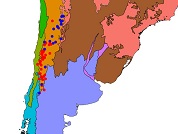Distribution models and morphometric analyses in Deyeuxia velutina, an Andean grass species
DOI:
https://doi.org/10.14522/darwiniana.2020.82.894Keywords:
Diagnostic characters, geographical patterns, morphometry, integrative taxonomyAbstract
Rúgolo de Agrasar recognized two varieties of Deyeuxia velutina (D. velutina var. velutina and D. velutina var. nardifolia) based on leaf sheath indumentum, lemma length, and leaf blade direction. However, taxonomic delimitation has been difficult due to occasional overlapping characters. To assess the infraspecific delimitation of D. velutina, we present a comprehensive study combining morphometric analyses and a potential distribution model. To explore morphological variation and select diagnostic characters, we measured 124 morphological characters in 52 specimens of both varieties and performed a principal coordinate analysis and univariate analyses (Analysis of variance and Kruskal-Wallis non-parametric test). Both taxa resolved as separate morphological groups. Additionally, a Discriminant Analysis was performed to classify the individuals in the predetermined morphological groups. For modeling the species distribution, 26 specimens of D. velutina var. nardifolia and 68 of D. velutina var. velutina were georeferenced and 20 environmental variables were analyzed through a Maximum Entropy model. Deyeuxia velutina extends in the high Andean region from Peru to southern Argentina and Chile. Both varieties differed in their geographical limits, a result supported by regression analyses of latitude and longitude on the principal coordinates of the PCoA. Deyeuxia velutina var. nardifolia is restricted to the northern area of distribution while D. velutina var. velutina showed a higher habitat suitability in the southern region. Moreover, D. velutina var. nardifolia is here reported for the first time in San Juan province (Argentina), constituting the austral limit of its geographical distribution. Additional reliable morphological characters were considered in an updated key to the varieties.

Downloads
Published
How to Cite
Issue
Section
License

Starting on 2012, Darwiniana Nueva Serie uses Licencia Creative Commons Atribución-NoComercial 2.5 Argentina .





